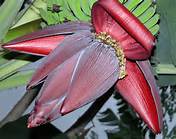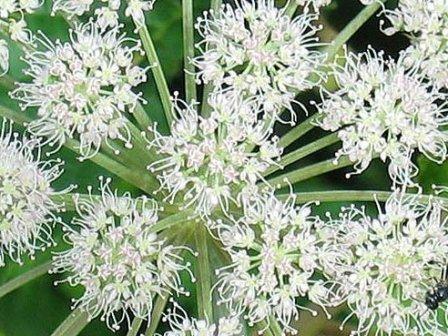Edible Flower In The Garden

.jpg?timestamp=1382495902364)

Want to know if a plant you're considering grow has edible flowers? This is the place to look.
Note: While the flowers mentioned in the edible flowers list are edible, other parts of the plants mentioned in this list may be poisonous. Know what you're eating!
Allium blossoms (leeks, onion, garlic, chives, etc.)
Angelica (Angelica archangelica)
Anise Hyssop (Agastache foeniculum)
Apple blossoms (Malus species) -- eat in moderation as they contain small amounts of cyanide, just as apple wood, leaves, and seeds do.
Artichoke (Cynara cardunculus) -- the immature flower bud is edible, the mature flower is not
Arugula (Eruca vesicaria) -- flowers have a milder taste than leaves, great in salads or as a snack
Bachelor's button (Centaurea cyanus) -- petals only
Banana blossoms (Musa paradisiaca)
Basil (Ocimum basilicum)
Bee Balm (Monarda didyma)
Borage (Borago officinalis) -- can have a diuretic effect, eat in moderation
Broccoli (Brassica oleracea) -- the heads are composed of flower buds, flowers taste like broccoli
Calendula (Calendula officinalis) -- slightly bitter, used more for the color than the flavor
Carnations (Dianthus caryophyllus) -- petals; remove bitter white base
Cauliflower -- the part you eat is made up of flower buds
Chamomile (Chamaemelum noblis) -- for tea; use in moderation. If you're allergic to ragweed you may be allergic to chamomile as well.
Chervil (Anthriscus cerefolium)
Chicory (Cichorium intybus)
Chives (Allium schoeonoprasum) -- very strong onion taste
Chrysanthemum (Chrysanthemum morifolium or Chrysanthemum indicum) -- petals, remove the bitter white base, strong flavor, used in tea
Citrus blossoms (orange, lemon, lime, grapefruit, kumquat)
Clover -- use dried in tea
Coriander (Coriandrum sativum)
Cornflower (Centaurea cynaus)
Dandelions (Taraxacum officinale) -- use young flowers and buds, mature flowers are bitter
Dianthus -- remove the bitter narrow base
Dill (Anethum graveolens)
Daylilies (Hemerocallis) -- buds, flowers, petals; eat in moderation, can have diuretic and laxative effects
Elderflower (Sambucus species) -- blossoms for tea; washing flowers removes much of the flavor
English Daisy (Bellis perennis) -- mildly bitter taste
Fennel (Foeniculum vulgare)
Fireweed (Epilobium angustifolium)
Fuchsia (Fuchsia X hybrida)
Garden Sorrel (Rumex acetosa) -- taste like lemon!
Garland chrysanthemum (Chrysanthemum coronarium) -- petals
Garlic (Allium sativum) -- garlic flowers have a mild garlic flavor and are nice in salads
German chamomile (Matricaria recutita)
Ginger (Zingiber officinale)
Gladiolus -- remove anthers
Green alkanet (Pentaglottis sempervirens) -- only the flowers are edible
Hesperis matronalis (young leaves, flowers)
Hibiscus (Hibiscus rosa-sinensis) -- citrus flavor, often used as a garnish
Hollyhock (Althea rosea) -- vegetable flavor, often used as a garnish
Honeysuckle (Lonicera japonica) -- other species called "honeysuckle" are not edible.
Impatiens (Impatiens wallerana)
Jasmine (Jasminum sambac, Jasmine officinale) -- "false jasmine" is poisonous
Johnny Jump-Ups (Viola tricolor) -- wintergreen flavor. Eat in moderation, contains saponins which are toxic in large amounts
Lavender (Lavandula angustifolia) -- intense flavor
Lemon Verbena (Aloysia triphylla)
Lilac (Syringa vulgaris) -- wide variation in flavor, taste before buying the plant
Linden (Tilla species) -- use in moderation; overuse of linden flower tea can cause heart damage
Lovage (Levisticum officinale) -- taste like celery
Marigold (Tagetes tenuifolia, T. signata, T. patula) -- wide variation in flavor, taste before buying
Marjoram (Origanum majorana)
Mint (Mentha species) -- there is a wide variation in flavor with mint flowers, taste before buying
Moringa oleifera
Mustard (Brassica species) -- some people are highly allergic to mustard, start with a small amount.
Nasturtium (Tropaeolum majus) -- nasturtium flowers have a spicy, peppery taste
Okra (Abelmoschus esculentus)
Oregano (Origanum vulgare)
Ox-Eye Daisy (Chrysanthemum leucanthemum)
Pak Choy (Brassica chinensis)
Pansy (Viola Wittrockiana)
Passion flower (Passiflora spp.) -- vegetable flavor, often used as a garnish
Pea blossoms (Pisum sativum) -- the flower called "sweet pea" is poisonous
Peony (Paeonia lactiflora)
Perennial peanut (Arachis glabrata) -- flowers taste like peanuts, good lawn alternative or ground cover in subtropical areas
Perennial Phlox (Phlox paniculata) -- other species of Phlox (such as annual or creeping phlox) are not edible
Pineapple Guave (Feijoa sellowians)
Pineapple sage (Salvia elegans) -- minty, spicy flavor
Pomegranate (Punica granatum)
Primrose (Primula vulgaris)
Pumpkin blossoms
Pot Marigolds (Calendula officinalis) -- petals; remove bitter white base
Quince -- flowers have a mild almond taste; eat in moderation
Radish (Raphanus sativus)
Red clover (Trifolium pratense) -- dry for tea
Rose (Rosa spp.) -- remove white bitter base of the petal.
Rosemary
Safflower (Carthamus tinctorius)
Sage (Salvia officinalis)
Savory (Satureja hortensis)
Scarlet Runner Beans (Phaseolus vulgaris)
Scented Geraniums (Pelargonium species) -- flower tastes like the smell of the leaves
Sesbania bispinosa
Sesbania grandiflora
Signet marigold (Tagetes signata) -- eat in moderation, may be harmful in large amounts
Snapdragon (Anthirrhinum majus) -- bitter flavor, usually used as a garnish
Squash blossoms
Strawberry flowers (Fragaria ananassa)
Summer savory (Satureja hortensis)
Sunflower (Helianthus annuus) -- bud tastes like artichoke, petals have a bittersweet flavor. Some people have allergic reactions to the pollen.
Sweet Olive (Osmanthus fragrans)
Sweet Woodruff (Galium odoratum) -- eat in moderation, can have blood thinning effect
Thyme (Thymus species)
Tuberous Begonia (Begonia X tuberosa) - only hybrids are edible.
Tulip (Tulipa) -- petals only. Some people are strongly allergic: if touching tulips causes itching, numbness or rash don't eat them!
Violet (Viola odorata and other Viola species) -- candied violets are especially good on bakery items.
Yucca Petals (Yucca species)
Zucchini blossoms
Warning:
Some parts of edible plants are poisonous. Others may be edible only after appropriate preparations (such as cooking or pickling).
Although I make every possible effort to notify you in these pages of toxic parts of edible plants, or of flowers or plants that may be misidentified as edible, it is your responsibility to determine the identity of any plant, the edible parts of that plant, and the proper way to prepare the plant, before you eat it.
Only eat flowers which have been organically grown, because the sprays used on non-organically grown flowers often are not safe to eat.
Just because something is edible doesn't mean you will like its taste! Use common sense when adding a new food, especially edible flowers.
Allergic reactions are possible while eating any plant, especially from eating pollen, even if you have done so safely before. Some flowers or plants are not safe if eaten often, or if eaten by people with certain medical conditions. Please check with your health provider before eating a new food if there is any question as to whether this food is safe for you.
Be Safe! Prevent Allergic Reactions
Any new food, plant or flower could cause allergic reactions when eaten, which can become life-threatening.
To help prevent a serious allergic reaction, here are some steps to take when considering any plant that you have never eaten before. Only go to the next step if your answer is "no".
Severe reactions such as shortness of breath, face swelling, or throat swelling are signs of an extreme allergic reaction -- call for emergency medical attention immediately.
Touch the plant or flower part that you intend to eat with the back of your hand. Does it irritate your skin or cause you to itch? If the answer is yes, STOP. You may be allergic to it. Do not eat this.
Break off a small piece of the plant or flower part that you intend to eat and hold it next to your inner wrist for 15 minutes. You can do this as you walk around the nursery. Does the piece of plant cause redness, irritation, swelling, rash, or itching? If the answer is yes, STOP. You may be having an allergic reaction to it. Do not eat this.
Place a piece of the plant or flower part that you're testing in your mouth and hold it there for 15 minutes. Was there any numbness, tingling, swelling, or burning in your mouth?If the answer is yes, spit it out. You may be allergic to it. Do not eat this.
Prepare a small amount of the plant (1-3 spoonfuls) as recommended for that plant, and eat it. Wait 24 hours. Did you have any symptoms such as nausea, heartburn, or diarrhea, or feel unwell in any way after eating this plant? If the answer is yes, stop eating this plant. You may be having an allergic reaction to it. If you have already bought the plant, either return it to the store or exchange it with a friend who isn't allergic to it.
If all the answers have been "no", congratulations! You have found a new edible plant that you are not allergic to.
Don't forget to do this allergic reaction testing on family members, especially children and the elderly, if they have never eaten this plant before.
Remember that food allergic reactions can develop over time, even in foods you have eaten before, so if you have any of these symptoms after eating a certain food, consider reducing your exposure to that food.
Cautions
Not all flowers are edible; some may taste bad and some are poisonous. Eat flowers only if you are certain they are edible. Consult a good reference book.
A flower is not necessarily edible because it is served with food. A partial list of edible flowers can be found in Table 1. The flowers of most culinary herbs are safe to use.